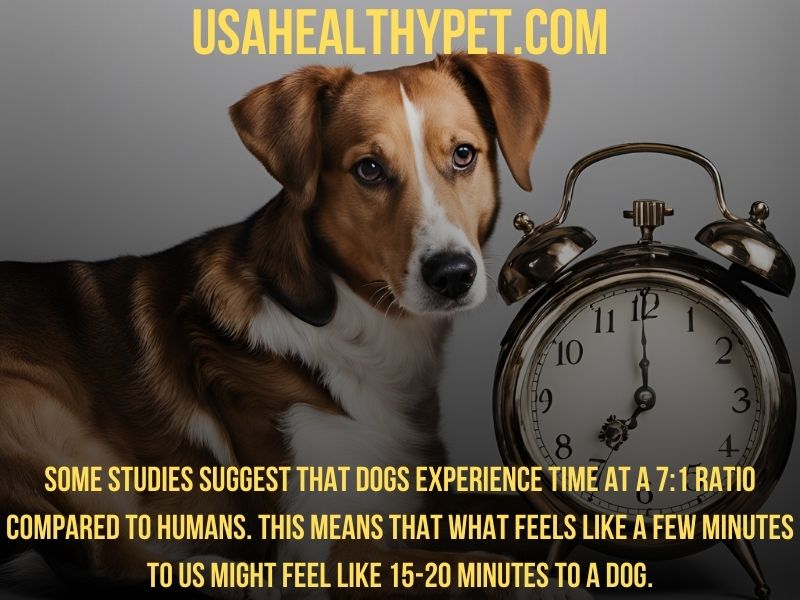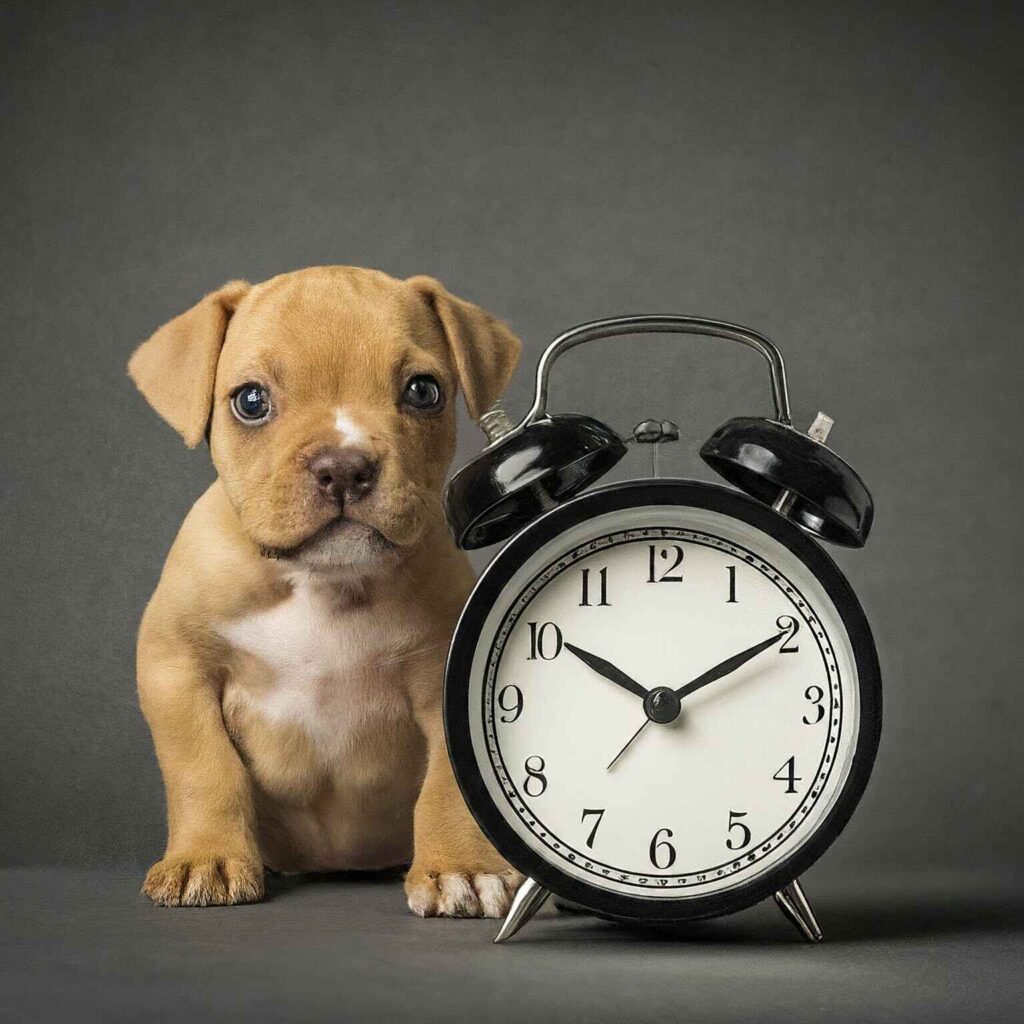So, how do dogs perceive time? Imagine living in a world where the concept of minutes and hours doesn’t exist.
Dogs world revolves around routines, smells, and our presence.
In human terms, what feels like a few minutes to us can seem like 15-20 minutes to a dog, thanks to their heightened senses and faster metabolic rates.
Key Points:
- Dogs perceive time through routines and environmental cues, not clocks. Their sense of time revolves around daily habits, light changes, and human presence.
- A few minutes for humans can feel like 15-20 minutes for dogs due to their heightened senses and faster metabolic rates.
- Separation anxiety can make short absences feel much longer. Even a brief departure can seem like an eternity to a dog with anxiety.
- Dogs rely on associative memory—they remember actions like putting on shoes (indicating you’re leaving) but don’t recall exact durations.
- Keeping a consistent routine helps dogs feel secure and reduces stress when left alone.
- Interactive toys and puzzle games can keep dogs mentally stimulated, making waiting periods easier.
- Pet cameras with audio features can provide comfort for both you and your dog during long absences.
- Age, breed, and activity level influence a dog’s perception of time. Younger, more energetic dogs may experience time more intensely than older, calmer dogs.
- Dogs live in the moment and don’t dwell on the past or anticipate the future, making each moment with you precious.
Understanding Dog Perception of Time
Dogs experience time differently than humans do. While we rely heavily on clocks and schedules, dogs don’t. Dogs have internal biological clocks that help them understand daily routines.
They know when it’s time to eat, walk, or play because their bodies get used to these activities happening at certain times. Their world revolves around routines, smells, and our presence.
The Science Behind Dog Time
Research shows that animals, including dogs, perceive time through a combination of biological and psychological processes.
Dogs don’t watch the clock, but they can sense the passage of time through changes in light, temperature, and their physical states.
Veterinarians and animal behaviorists agree that dogs have a different sense of time.
Dr. Alexandra Horowitz, a renowned animal behaviorist, suggests that dogs’ sense of time is more about routines and less about the ticking clock.
They use cues from their environment to gauge time intervals.

How Long is a Few Minutes in Dog Time?
For us, a few minutes might mean 2 to 5 minutes. For dogs, this short span can feel like 15-20 minutes, due to their different perception of time.
Factors Affecting a Dog’s Perception of Time
- Age and Breed: Younger dogs and certain breeds may experience more intense time due to higher energy levels.
- Daily Routines and Activities: Consistent schedules help dogs anticipate events, making time feel structured.
- Environmental Factors: Changes in surroundings can alter a dog’s perception of time, making moments feel longer or shorter.
- Activity Level: A dog that’s bored or waiting can feel that a few minutes on forever. On the other hand, a dog that’s busy playing or exploring barely notices the time.
- Attention and Distraction: When dogs are focused on something interesting, time seems to fly by.
- Separation Anxiety: For dogs with separation anxiety, even a few minutes away from their owner can feel like an eternity.
Comparative Analysis
Minutes to Hours Ratio
Some studies suggest that dogs experience time at a 7:1 ratio compared to humans. This means that what feels like a few minutes to us might feel like 15-20 minutes to a dog.
Dogs live in the moment. They don’t dwell on the past or worry about the future. This trait makes their perception of time quite different from ours.
Scientists believe that dogs might experience time more like a series of events rather than a continuous flow.
The Role of Memory
Dogs have associative memory. This means they remember things based on associations rather than a timeline.
For example, they might remember that when you put on your shoes, it often means you’re leaving. But they don’t remember that you left for exactly 15 minutes yesterday.
Understanding Dog Aging and Time Perception
Dogs age and perceive life differently than humans. Let’s explore how this impacts their perception of time.
Comparing Human and Dog Aging Processes
| Human Years | Dog Years (Small Breed) | Dog Years (Large Breed) |
|---|---|---|
| 1 | 15 | 12 |
| 5 | 36 | 42 |
| 10 | 56 | 60 |
Comparing Human and Dog Aging Processes (Minutes)
| Human Time | Dog Time (Small Breed) | Dog Time (Medium Breed) | Dog Time (Large Breed) |
|---|---|---|---|
| 1 minute | 15 minutes | 13 minutes | 12 minutes |
| 5 minutes | 1 hour 15 minutes | 1 hour 5 minutes | 1 hour |
| 10 minutes | 2 hours 30 minutes | 2 hours 10 minutes | 2 hours |
| 60 minutes | 15 hours | 13 hours | 12 hours |
Practical Implications for Dog Owners
Training and Routines
Dogs thrive on consistency. Establishing regular routines for feeding, walking, and playtime helps them feel secure.
Managing Separation
For dogs with separation anxiety, practice leaving them alone for short periods and gradually increasing the duration to help them adjust.
Play and Exercise
Keep your dog mentally and physically stimulated with engaging activities. Puzzle toys, interactive games, and regular exercise are great ways to keep them happy and healthy.

A Day in the Life of a Dog
Let’s break down a typical day from a dog’s perspective. When you leave for work, your dog might initially feel a bit anxious. They don’t know if you’ll be gone for a few minutes or several hours.
Over time, they might get used to your schedule and become more relaxed, knowing you’ll eventually return.
Morning Routine
Your dog wakes up when you do, ready for breakfast and a morning walk. This part of the day is all about routine. They know that after you have your coffee, it’s time to head out.
Afternoon Nap Time
During the day, while you’re away, your dog might nap, play with their toys, or watch the world go by from a cozy spot. They live in the moment, enjoying the simple pleasures of life.
Evening Excitement
When you return, it’s like a mini celebration. Whether you were gone for a few minutes or several hours, your dog has missed you.
Their joy and excitement are genuine, showing just how much they value your presence.
How Long Can Dogs Be Left Alone?
The maximum time a dog can be left alone depends on several factors:
- Puppies: Generally, no more than 2-3 hours at a time.
- Adult Dogs: Up to 4-6 hours, but this varies by individual needs.
- Senior Dogs: Often require more frequent breaks due to health issues.
Balancing your work schedule with pet care might require hiring a dog walker or asking a neighbor for help.
How to Make Waiting Easier for Your Dog
Now that we understand how dogs perceive time, let’s talk about making their waiting period easier. Here are a few tips:
Create a Comfortable Space
Make sure your dog has a cozy spot to relax when you’re away. A comfortable bed, some toys, and maybe a piece of your clothing can help them feel secure.
Stick to a Routine
Dogs thrive on routine. Try to leave and return at the same time every day. This consistency helps them feel more at ease.
Use Puzzles and Toys
Interactive toys and puzzles can keep your dog mentally stimulated while you’re gone. These distractions can make the time pass more quickly for them.
Consider a Pet Camera
A pet camera can be a great way to check in on your dog while you’re away. Some cameras even allow you to talk to your pet, which can be comforting for both of you.
Conclusion
So, how long is a few minutes in dog time? Time for dogs is a blend of routine, environment, and instinct.
By understanding how they perceive it, we can create more meaningful interactions and ensure their happiness. Remember, your dog lives in the moment, so make every second count!
FAQs
1. Do dogs have a sense of time?
Dogs don’t perceive time like humans do. They rely on routines and events rather than minutes and hours.
2. How can I help my dog feel less anxious when I’m away?
Creating a comfortable space, sticking to a routine, and using interactive toys can help ease your dog’s anxiety.
3. Do dogs remember how long we’re gone?
Dogs remember events based on associations, not specific timelines. They know you’ll come back, but not exactly when.
4. Can a pet camera help my dog feel less lonely?
Yes, a pet camera can allow you to check in and even talk to your dog, which can be comforting

Pingback: What is a Skinwalker Dog? How to Identify and Respond
Pingback: Are Dog Years and Cat Years the Same? Unveiling the Truth